Here, you’ll find my complete video series on Functional Analysis, presented in the correct order. Alongside the videos, I provide helpful text explanations. To test your knowledge, take the quizzes, work through the included exercises, and refer to the PDF versions of the lessons if needed. If you have any questions, feel free to ask in the community forum. Now, without further ado, let’s get started!
Part 1 - Introduction and Metric Space
Functional analysis is a video series for everyone that is interested in mixing Linear Algebra with Real Analysis. Let’s do it:

Content of the video:
00:00 Introduction into functional analysis
01:49 Metric space (introduction)
02:25 Metric (definition)
03:20 Metric (definiteness)
03:36 Metric (symmetry)
04:07 Metric (triangle inequality)
05:31 Credits
So a metric is a notion of a distance, which can give any set a structure such that one sees how far or close two points are. This is something we already can do with numbers but now we want to extend this viewpoint even to abstract spaces
Part 2 - Examples for Metrics
Knowing what a metric should do is very nice, so let’s apply our knowledge to some examples:
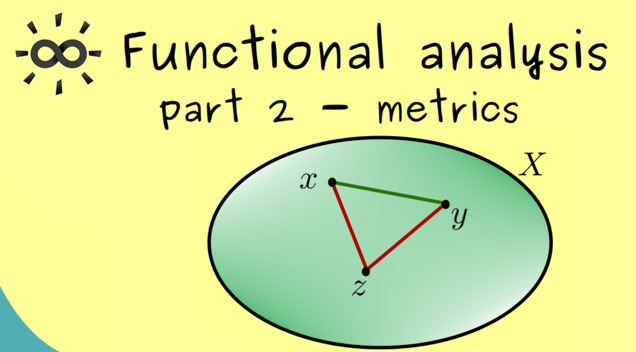
Content of the video:
00:00 Introduction
00:16 Metric space
00:45 Examples
04:07 Discrete metric space
Part 3 - Open and Closed Sets
Having a metric, which is a notion of distance, we describe what open or closed sets are:
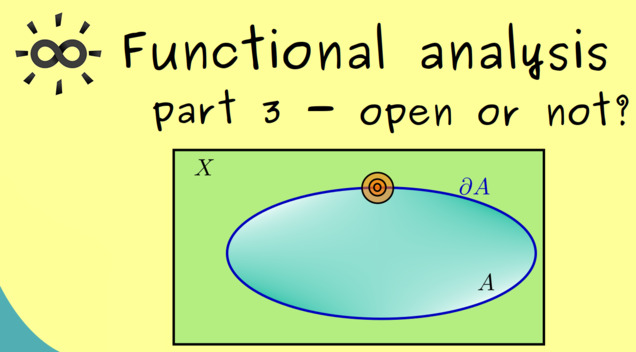
Content of the video:
00:00 Introduction
00:37 Epsilon ball
01:35 Notions
06:24 Examples
Part 4 - Sequences, Limits and Closed Sets
A nice thing we can in a metric space is to describe a lot of properties with the help of sequences. They work the same as sequences with real numbers, for example. Hence, the definition for a convergent sequence and its limit looks indeed similar. You just have to put in the metric when measuring the distance between a member of a sequence and the limit. With that tool in our tool-set we can characterise a closed set by using sequences:

Content of the video:
00:00 Introduction
00:35 Sequence
01:01 Convergence
02:57 Closedness with sequences
04:12 Proof
Part 5 - Cauchy Sequences and Complete Metric Spaces
Another notion that one already knows from the real numbers is that of a Cauchy sequence. In general metric spaces, we can define it in the same way: the distance between two members should get arbitrarily small. This means that one would think that such a sequence has a limit. However, this does not have to be the case. This fact only holds in so-called complete metric spaces.

Content of the video:
00:00 Introduction
02:30 Cauchy sequences
03:34 Complete metric spaces
Part 6 - Norms and Banach Spaces
Now we have learnt so much about metric spaces that we can discuss another important structure in functional analysis: Banach spaces.
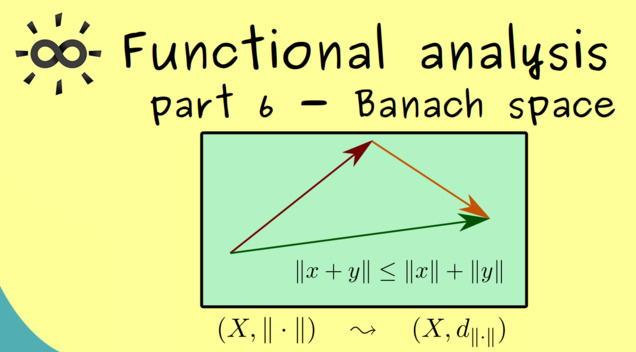
Content of the video:
00:00 Introduction
00:33 Definition (norm)
04:17 Normed space
04:50 Connection to metrics
06:00 Banach space
Part 7 - Examples of Banach Spaces
You see, a Banach space has a lot more structures than just a metric space. We have the whole underlying linear structure from the vector space and are also able to measure length of single vector. Together with the completeness, we have one of the most important object of study in functional analysis. Let’s look at a typical example:
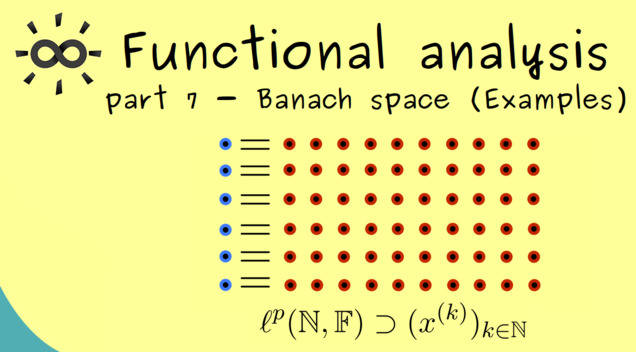
Content of the video:
00:00 Introduction
00:30 One-dimensional example
01:21 Zero-dimensional example
02:10 l^p-space
Part 8 - Inner Products and Hilbert Spaces
If you set p = 2 in the last example, you might recognise that is looks like the common euclidean norm in $ \mathbb{R}^n $ or $ \mathbb{C}^n $. From the last one, we already know that we are not only able to measure lengths but also angles! For measuring angles in an abstract vector space, we need to define a new structure: an inner product.
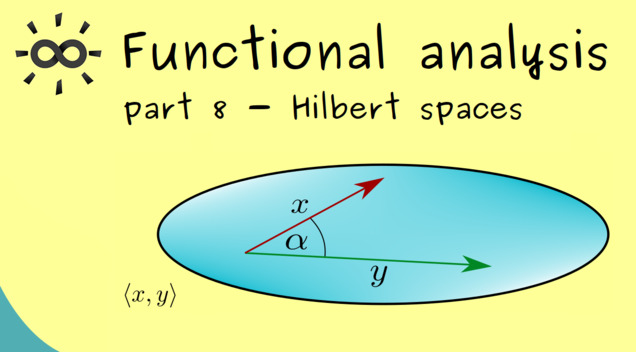
Content of the video:
00:00 Introduction
02:25 Inner product definition
06:25 Norm and Hilbert space
Part 9 - Examples of Inner Products and Hilbert Spaces
In the last video, you learnt what one of the most important objects of study in functional analysis: Hilbert spaces. To get an idea why they are so interesting, let’s look at some examples.

Content of the video:
00:00 Introduction
00:28 Examples
02:39 Checking properties for $\ell^2$
Part 10 - Cauchy-Schwarz Inequality
Having an inner product, one is able to connect this to an induced norm and one gets a very useful inequality:
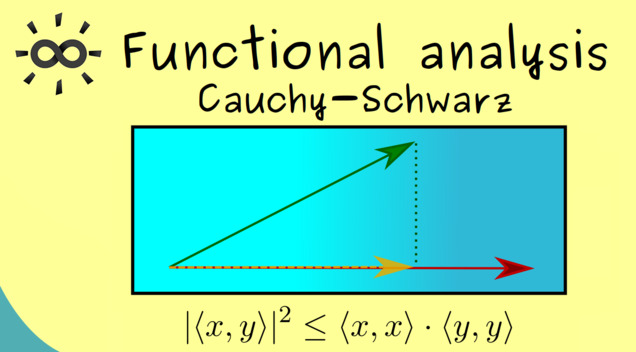
Content of the video:
00:00 Introduction
00:25 Cauchy-Schwarz inequality
02:00 Proof
08:15 Triangle inequality for the norm
Part 11 - Orthogonality
The Cauchy-Schwarz inequality hints to a definition of angles, we might know, e.g., in $ \mathbb{R}^n $. So let’s generalise this idea in an abstract sense:

Content of the video:
00:00 Introduction
00:20 Definitions
01:58 Remark
03:43 Visualisations
04:58 Credits
Part 12 - Continuity
As an interlude, let’s go back to the basics. We take metric spaces and look at a map between them. Such a map is called continuous if it satisfies the same rules as a continuous function which you might already know. In general, continuity means that preimages of open sets are again open sets. However, in metric spaces this can be described equivalently by sequences. Hence one calls this often sequentially continuous:
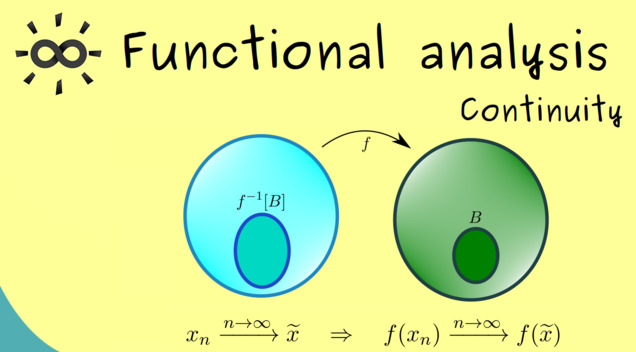
Content of the video:
00:00 Introduction
00:20 Definition - continuity
09:56 Orthogonal complement is closed
Part 13 - Bounded Operators
So we have learnt that the inner product $ \langle \cdot, \cdot \rangle $ is a continuous map. This will be used a lot! An with this you have seen a first example of an operator. Most of time, when we say “operator” we mean a linear map between normed spaces and often they are also continuous:
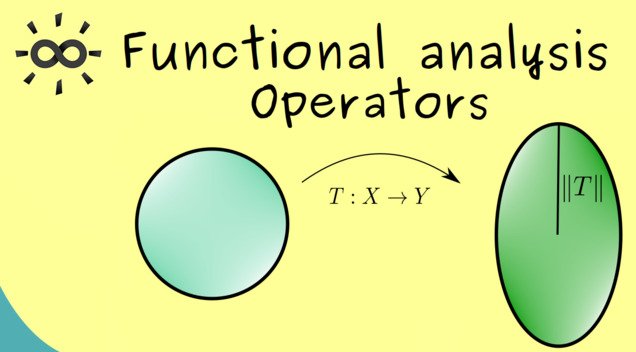
Content of the video:
00:00 Introduction
01:40 Definition - bounded operator
04:35 Proposition - continuous equivalent to bounded
Part 14 - Example Operator Norm
Let’s consider an example to get an idea what bounded linear operators really are:

Content of the video:
00:00 Introduction
00:15 Example
01:27 First estimate
03:30 Second estimate
Part 15 - Riesz Representation Theorem
About bounded operators, we will talk a lot in later videos because they occur in many applications and are, therefore, one of the most interesting and important objects of study in functional analysis. By the way, you might wonder what the name “functional” means: This is just a special linear operator that maps into the number field. Especially for Hilbert spaces, these functionals can be very nicely described by the Riesz representation theorem:

Content of the video:
00:00 Introduction
00:29 Riesz representation theorem
02:45 Proof Existence
07:25 Proof Uniqueness
08:10 Proof Operator Norm
Part 16 - Compact Sets
For the moment, I want to go back to the beginning when we are talking about metric spaces. There were a lot of topological notions we defined for metric spaces: open sets, closed sets, boundary points and even continuity. However, there is another very important one: compact sets. They generalise some ideas we have for finite sets to the infinity, with which we deal a lot in functional analysis. Therefore the idea is not easy to grasp at the beginning . However, in metric spaces, we can describe it with the help of sequences:

Content of the video:
00:00 Introduction
00:40 Compactness in $\mathbb{R}^n$
01:46 Definition: sequentially compact
04:00 Examples
05:52 Proposition: compact implies closed and bounded
07:14 Proof
Part 17 - Arzelà–Ascoli Theorem
If we now look at sets in a normed spaces, we get the classical result that in a finite-dimensional space all bounded and closed sets are also compact. However, we already learnt that this is not correct in general and in the next video we see that in an infinite-dimensional space we need more. Indeed, the Arzelà-Ascoli theorem tells us what the missing ingredient for compactness is for a special case:
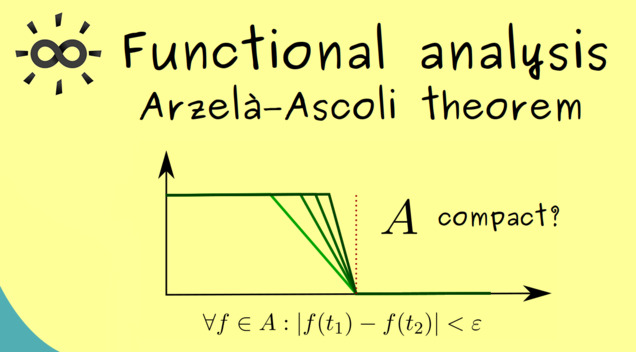
Content of the video:
00:00 Introduction
00:32 Examples
04:05 Continuous functions
06:07 Equicontinuity
07:43 Examples (Equicontinuity)
11:25 Arzelà–Ascoli theorem
12:59 Credits
Part 18 - Compact Operators
Let’s now apply the Arzelà-Ascoli theorem in the context of so-called compact operators. The name suggests that these operators generalise the well-known matrices or operators in finite-dimensional spaces just a little bit. Indeed, that is the whole idea as we will discuss it in the next video:
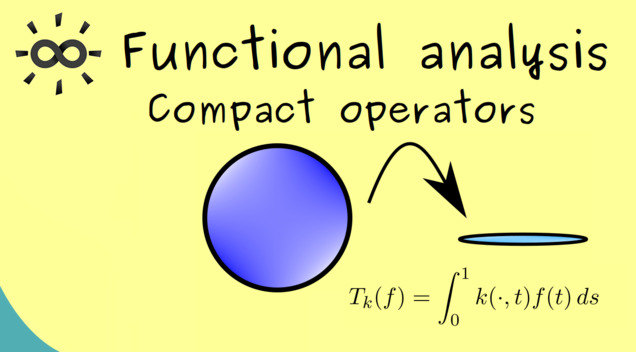
Content of the video:
00:00 Introduction
02:39 Definition
03:13 Example
Part 19 - Hölder’s Inequality
This is now a good point to gather one’s breath and to take a break. Before we continue with the interesting topics around operators, we should go back to basics, in particular to the Banach space $ \ell^p(\mathbb{N}) $. You might recall that we have proven the completeness but skipped showing the triangle inequality for the $ \lVert \cdot \rVert_p $-norm. We did this because there is some technical work needed to show this in full glory. Now after seeing that there are so many interesting things to find when analysing such Banach spaces, we can repay the debts and dive into the technical proofs. This is what we do in the next to videos:

Content of the video:
00:00 Introduction
01:42 Hölder’s Inequality
02:19 Young’s Inequality
05:11 Proof
Part 20 - Minkowski Inequality
The following video is about another famous inequality. It’s what we need to understand the most important examples of Banach spaces, which are the $\ell^p$-spaces.
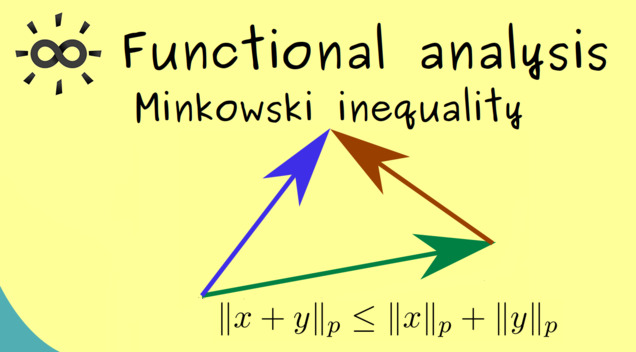
Content of the video:
00:00 Introduction
01:00 Proof
Part 21 - Isomorphisms?
We already deep in this wide field of functional analysis and have most of the basics behind us. The next big topic, we will tackle is the so-called dual theory which deals with dual spaces of normed spaces. However, before we can start talking about these, we first have to be sure that everyone know what isomorphisms for Banach spaces are:
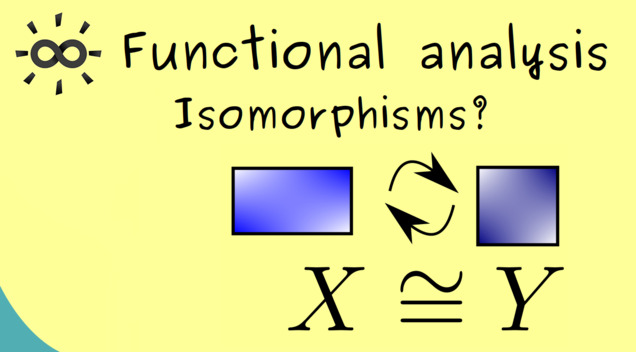
Content of the video:
00:00 Introduction
00:50 Example
04:18 Isomorphism
07:31 Examples
Part 22 - Dual Spaces
Now let’s discuss dual spaces of normed spaces. We show that they are always Banach spaces:
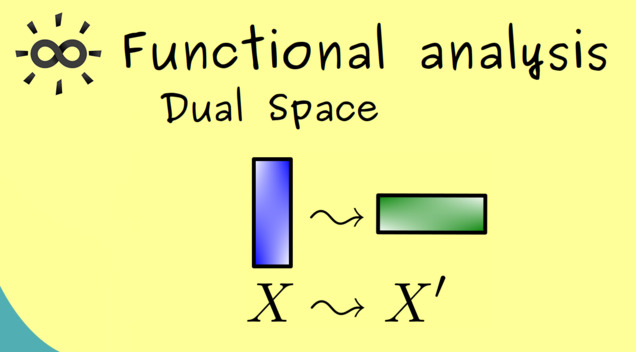
Content of the video:
00:00 Introduction
00:51 Definition of dual space $X^\prime$
01:45 Correction: Riesz says $X$ and $X^\prime$ are connected by an conjugate-linear bijection that is also isometric
02:43 Proposition: $X^\prime$ is always complete.
02:55 Proof that dual space is Banach space.
Part 23 - Dual Space - Example
Dual spaces sound like fun and they really are! 🙂 The next example shows how dual spaces can be used to switch between some $ \ell^p(\mathbb{N}) $-spaces.

Content of the video:
00:00 Introduction
00:31 Example
03:13 Proof
Part 24 - Uniform Boundedness Principle / Banach–Steinhaus Theorem
Let’s look at all the cool stuff we have already discovered in functional analysis: We know how to deal with linear bounded operators and we know that continuous and bounded are equivalent terms for linear operators. This is such a nice result that we can ask what happens in a limit process of operators. Is the limit still bounded? The Banach-Steinhaus theorem answers this question for us:
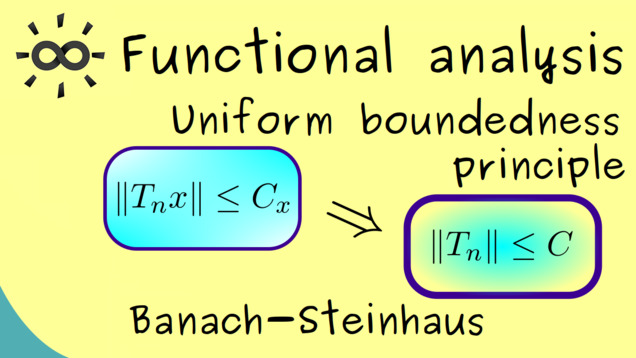
Content of the video:
00:00 Introduction
01:19 Theorem
03:20 Proposition
04:33 Proof
Part 25 - Hahn–Banach Theorem
Let’s immediately go to another important result in functional analysis: The Hahn-Banach theorem. It is connected to linear functionals, so the dual space of a normed space. Indeed, the most important corollary from this theorem is that we always find non-trivial linear functionals that vanish on a given closed subspace.
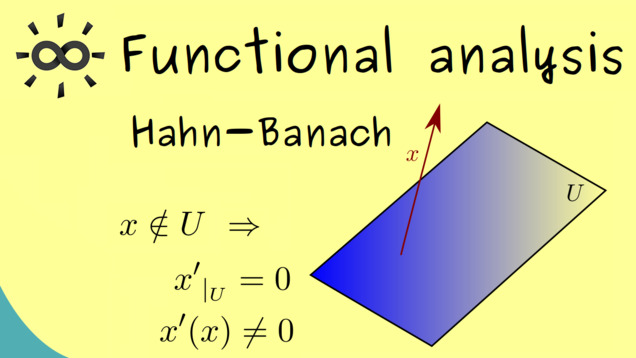
Content of the video:
00:00 Introduction
00:20 Hahn-Banach (extension version)
02:03 Applications
Part 26 - Open Mapping Theorem
Talking about important results in functional analysis, another one is the famous open mapping theorem:
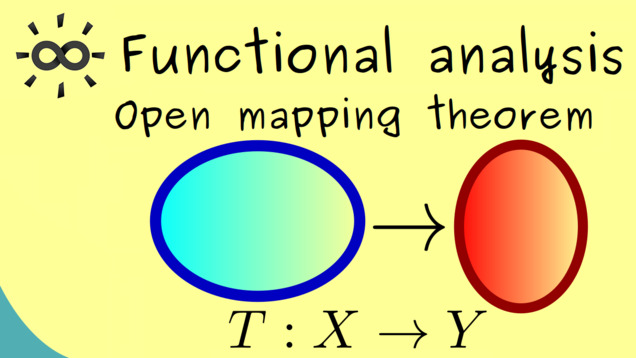
Content of the video:
00:00 Introduction
01:15 General example
02:47 Examples
03:47 Theorem
Part 27 - Bounded Inverse Theorem and Example
The most important implication from the open mapping theorem is the bounded inverse theorem:
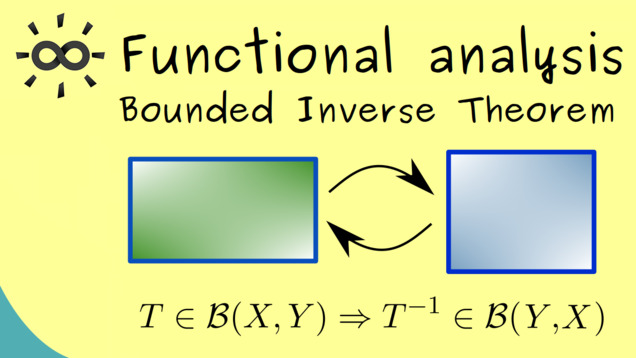
Content of the video:
00:00 Introduction
01:30 Counterexample
Part 28 - Spectrum of Bounded Operators
In the next videos, I want to start with spectral theory. Here, the so-called spectrum for a bounded operator is a generalisation of the eigenvalues of a matrix:
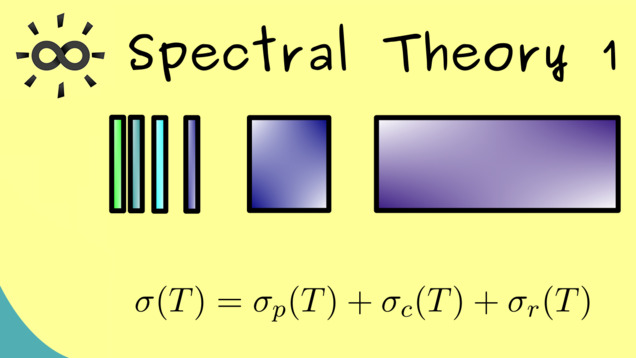
Part 29 - Spectrum of Multiplication Operator
Here, we look at an important example for the spectrum of operators. We take a multiplication operator which generalizes a diagonal matrix in some sense.
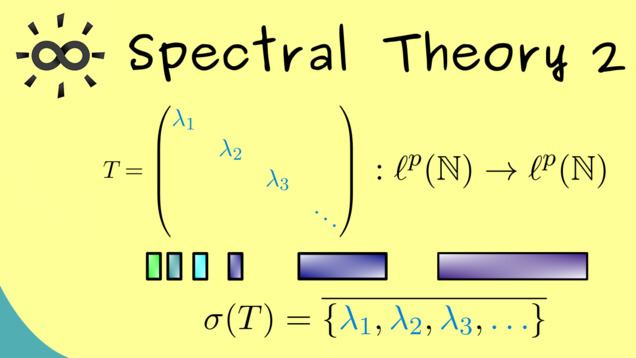
Part 30 - Properties of the Spectrum
Let’s discuss some general features of the spectrum.
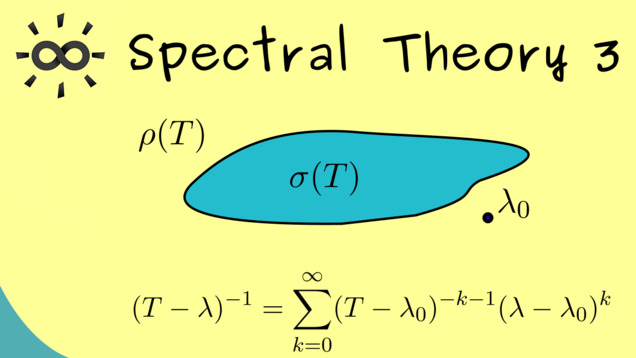
Part 31 - Spectral Radius
The next video is about the spectral radius. We also show that for bounded linear operators the spectrum can never be empty.
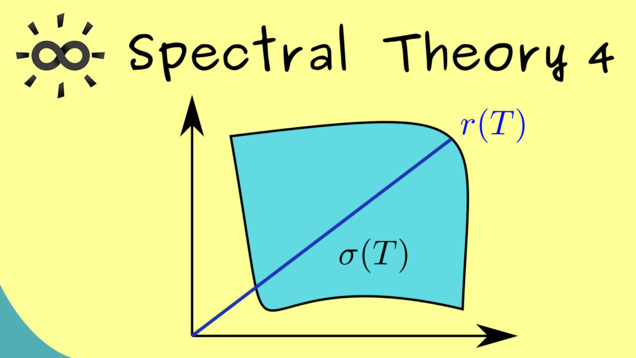
Part 32 - Normal and Self-Adjoint Operators
Now let us discuss normal operators and self-adjoint operators:
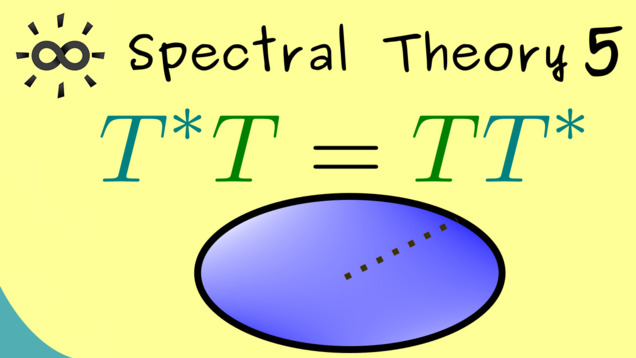
Part 33 - Spectrum of Compact Operators
In the next video, we go back to compact operators, which are close the linear operators between finite-dimensional spaces. In turns out that the spectrum of them has some nice properties.
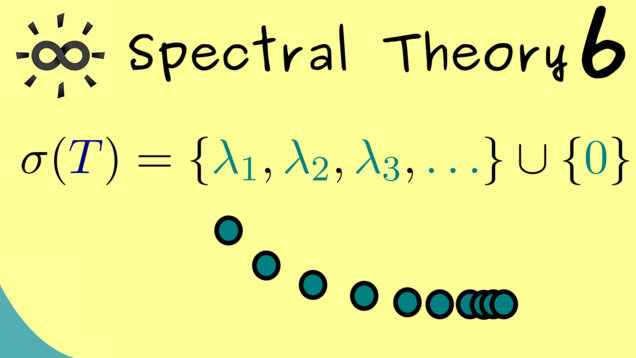
Part 34 - Spectral Theorem for Compact Operators
Now, we are ready to talk about the important spectral theorem, which sometimes is also called diagonalization of operators. It turns out that for compact operators one can do similar things as one knows from matrices. So we start discussing self-adjoint and normal compact operators.
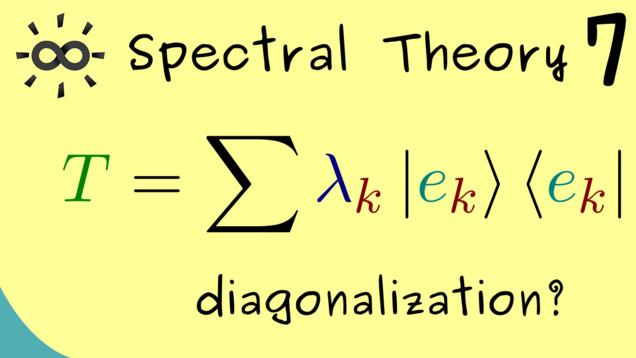
At the moment, this was the last video in the series but not the last video about the topic of Functional Analysis. We continue developing the whole theory in the next series, which we call Unbounded Operators. There we will finally define operators in the general sense. However, we will also develop a richer spectral theory such that we will really extend from the last videos here. Related to this series is also the video series about Hilbert Spaces and the video about the Baire Category Theorem.
Connections to other courses
Summary of the course Functional Analysis
-
You can download the whole PDF here and the whole dark PDF.
-
You can download the whole printable PDF here.
-
Test your knowledge in a full quiz.
- Ask your questions in the community forum about Functional Analysis.
Ad-free version available:
Click to watch the series on Vimeo.